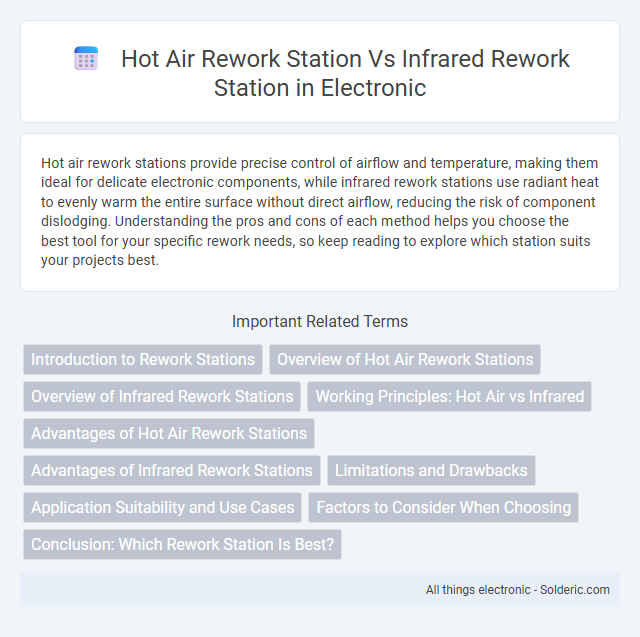Hot air rework stations provide precise control of airflow and temperature, making them ideal for delicate electronic components, while infrared rework stations use radiant heat to evenly warm the entire surface without direct airflow, reducing the risk of component dislodging. Understanding the pros and cons of each method helps you choose the best tool for your specific rework needs, so keep reading to explore which station suits your projects best.
Comparison Table
| Feature | Hot Air Rework Station | Infrared Rework Station |
|---|---|---|
| Heating Method | Convection heat via hot air | Infrared radiation |
| Temperature Control | Precise digital control, 100degC to 500degC | Accurate digital control, typically 100degC to 450degC |
| Heating Speed | Fast heating, adjustable airflow | Rapid, but depends on target material absorption |
| Component Suitability | Ideal for small to medium SMD components | Effective for large or unevenly shaped components |
| Risk of Thermal Shock | Lower risk due to gradual heat distribution | Higher risk; uneven heating can cause thermal stress |
| Precision | High precision with focused hot air nozzles | Moderate precision; heating less localized |
| Applications | PCB repair, soldering, desoldering of chips | Preheating, reflow of large PCB assemblies |
| Safety | Safer due to controlled airflow and heat | Potential for overheating surrounding areas |
| Cost | Generally lower cost | Higher cost, advanced technology |
Introduction to Rework Stations
Rework stations are essential tools in electronics repair and manufacturing, designed to precisely remove and replace surface-mounted devices. Hot air rework stations use controlled heated airflow to melt solder, allowing for safe component removal without direct contact. Infrared rework stations employ infrared radiation to evenly heat components, providing efficient energy transfer and reduced thermal stress on sensitive parts.
Overview of Hot Air Rework Stations
Hot air rework stations use a controlled stream of heated air to melt solder, enabling precise component removal and reflow on circuit boards. These stations are ideal for working with sensitive electronic parts, as the adjustable temperature and airflow minimize heat damage. Your choice of a hot air rework station ensures efficient repair and rework tasks with versatility in handling different soldering applications.
Overview of Infrared Rework Stations
Infrared rework stations use infrared radiation to heat electronic components precisely without direct contact, enabling efficient soldering and desoldering of sensitive parts. Their ability to provide uniform heat distribution minimizes thermal stress and reduces the risk of damaging nearby components compared to hot air rework stations. Understanding the advantages of infrared technology can enhance your rework process by improving accuracy and component safety.
Working Principles: Hot Air vs Infrared
Hot air rework stations operate by blowing a stream of heated air onto electronic components, allowing precise temperature control for soldering or desoldering without direct contact. Infrared rework stations use infrared radiation to transfer heat directly to the component, offering faster and more even heating but with less precise targeting. Your choice depends on the sensitivity of the components and the need for controlled heat application.
Advantages of Hot Air Rework Stations
Hot air rework stations provide precise temperature control and even heat distribution, reducing the risk of component damage during soldering or desoldering processes. Their ability to target specific areas with adjustable airflow enhances versatility for various surface-mount device (SMD) repairs. Compared to infrared rework stations, hot air systems offer better real-time temperature regulation and quicker cooling, improving overall repair efficiency.
Advantages of Infrared Rework Stations
Infrared rework stations offer precise and even heating by directly radiating heat to the component, reducing the risk of damaging sensitive parts compared to hot air rework stations. Your workflow benefits from faster thermal transfer and better temperature control, which improves soldering quality on intricate PCB assemblies. This method also minimizes airflow disturbances, making infrared stations ideal for reworking multi-layer boards or components with small leads.
Limitations and Drawbacks
Hot air rework stations may cause thermal stress or damage to sensitive components due to uneven heat distribution and exposure to high temperatures. Infrared rework stations often face limitations in precisely targeting specific areas, leading to potential overheating of adjacent parts and inconsistent soldering results. Your choice should consider these drawbacks to ensure optimal performance and avoid damage during electronic repairs.
Application Suitability and Use Cases
Hot air rework stations excel in precision soldering and desoldering small components on densely packed PCBs, making them ideal for tasks like repairing smartphones and fine-pitch IC rework. Infrared rework stations are better suited for uniform heating of larger or multilayered components, such as BGA packages and LED arrays, due to their ability to evenly distribute heat without direct airflow. Choosing between the two depends on the component size, board complexity, and the need to avoid thermal stress in sensitive electronic assemblies.
Factors to Consider When Choosing
When choosing between a hot air rework station and an infrared rework station, consider precision requirements, as hot air offers more control for delicate components, while infrared provides faster heating for larger areas. Evaluate the type of components you work with; hot air is ideal for surface-mount devices, whereas infrared suits heat-sensitive or unevenly shaped parts. Your budget and workspace constraints also play a crucial role, with hot air units typically being more affordable and compact compared to some infrared models.
Conclusion: Which Rework Station Is Best?
Choosing between a hot air rework station and an infrared rework station depends on your specific soldering needs and component sensitivity. Hot air stations provide precise temperature control and are ideal for delicate surface-mount devices, while infrared stations offer uniform heating suitable for larger components but may risk thermal stress. Your best option aligns with the complexity of your projects and the thermal requirements of the electronic parts you handle.
Hot air rework station vs infrared rework station Infographic

 solderic.com
solderic.com